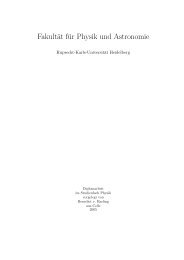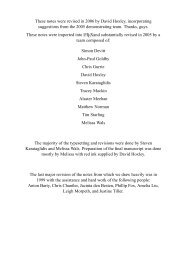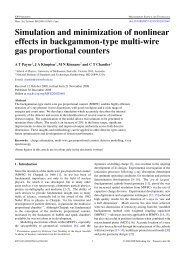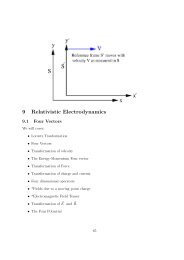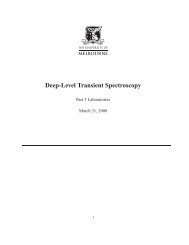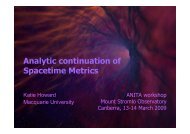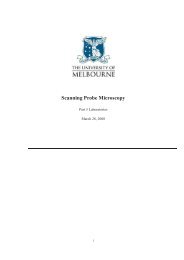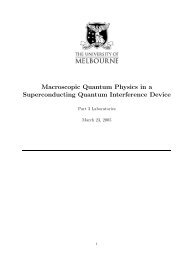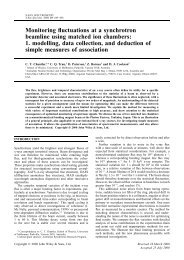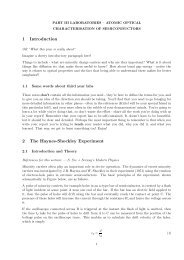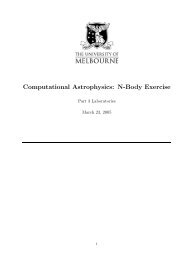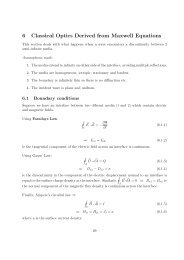Matthew John O'Dowd - School of Physics - University of Melbourne
Matthew John O'Dowd - School of Physics - University of Melbourne
Matthew John O'Dowd - School of Physics - University of Melbourne
You also want an ePaper? Increase the reach of your titles
YUMPU automatically turns print PDFs into web optimized ePapers that Google loves.
Host Galaxy Evolution in Radio-Loud AGN<br />
The host galaxies <strong>of</strong> radio-loud AGN appear to be normal elliptical galaxies in most respects,<br />
however at least one striking difference distinguishes them: both radio galaxies and the hosts<br />
<strong>of</strong> radio-loud quasars evolve in luminosity more strongly than brightest cluster galaxies (Lilly<br />
& Longair 1982; Aragon-Salamanca et al. 1993), other quiescent ellipticals (Stanford et al.<br />
1998; Kauffmann et al. 1996; Bell et al. 2004) or even radio-quiet quasar hosts (Kukula et<br />
al. 2001; Rix et al. 2001; Ridgway et al. 2001) The source <strong>of</strong> this difference is unknown, and<br />
may result from a variety <strong>of</strong> selection biases.<br />
Part <strong>of</strong> my Ph.D. work was the STIS imaging study <strong>of</strong> the host galaxies <strong>of</strong> z > 0.6 BL Lac<br />
objects to address the question <strong>of</strong> luminosity evolution in radio-loud hosts. BL Lacs have<br />
intrinsically low accretion rates and strongly beamed jets, which means they can be found<br />
in large numbers at moderate redshifts, and yet they aren’t strongly affected by extended<br />
emission line or dust-scattered light like quasars are. Additionally, their observed emission is<br />
dominated by the highly angle-dependent Doppler amplification <strong>of</strong> their jets. As such, any<br />
trend between host luminosity and intrinsic nuclear power (e.g. McLeod, Rieke & Storrie-<br />
Lombardi 1999; Dunlop et al. 2003) cannot result in spurious observations <strong>of</strong> host galaxy<br />
evolution in flux limited samples, as is a danger in studies <strong>of</strong> other AGN.<br />
The determination <strong>of</strong> the host galaxy properties was performed using new 2-D fitting<br />
techniques that I developed. Host galaxies were detected in five <strong>of</strong> the nine BL Lacs, three <strong>of</strong><br />
which are at higher redshift than any BL Lac host galaxy previously discovered.<br />
Combined with the low redshift hosts from our HST snapshot survey, we were able to<br />
measure luminosity evolution in these galaxies. I developed a new Monte-Carlo survival analysis<br />
method to rigorously account for our non-detections. Comparing with models <strong>of</strong> stellar<br />
population evolution, it was found that these host galaxies evolve strongly, consistent with<br />
passive evolution from a relatively low formation redshift <strong>of</strong> z form = 1.8 +1.0<br />
−0.5 , and inconsistent<br />
with either a evolution from a high formation redshift ( 5) or a non-evolving population,<br />
even taking evolution <strong>of</strong> dust and metallicity into account. Together with the increased incidence<br />
in merger remnants in the z > 0.6 BL Lacs, this strongly supports the idea that active<br />
star formation and galaxy interactions are associated with the formation <strong>of</strong> radio-loud AGN<br />
central engines.<br />
The luminosity evolution results indicate that the host galaxies <strong>of</strong> radio-loud AGN preferentially<br />
accrete less material after their formation epoch than brightest cluster galaxies and<br />
the hosts <strong>of</strong> radio-quiet AGN, and that by selecting radio-loud AGN at low redshifts, we are<br />
selecting those whose central SMBHs are relatively unaltered since a higher formation redshift.<br />
The results point to a scenario in which radio-loud AGN black holes are preferentially<br />
produced in a particular cosmic epoch: 0.5 z 2.5<br />
A Case Study <strong>of</strong> a Radio-Loud AGN Possibly in its Birth Phase<br />
This last result was highlighted dramatically by a further program, in which 1517+656 —<br />
a z = 0.702 BL Lac surrounded by a unusual, ring-like structure — was imaged with HST<br />
in multiple bands. Deep STIS imaging revealed the detailed structure <strong>of</strong> the arcs, allowing<br />
us to rule out gravitational lensing as a cause, and so leaving a galaxy interaction as the<br />
only possible explanation. WFPC2 imaging in the F555W (∼ V ) and F814W (∼ I) filters<br />
allowed us to model the stellar populations in the arcs, using the GISSEL population systhesis<br />
code <strong>of</strong> Bruzual & Charlot (1993), extended to non-solar metallicities (Westera et al. 2002).<br />
The populations were found to be very young, with the bluest having a maximum age <strong>of</strong><br />
0.02 Gyrs. The large mass contained in the arcs, and the high estimated Keplerian velocities<br />
6



